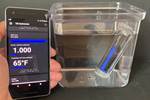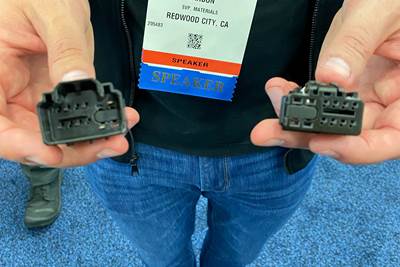A lot has happened since Formlabs held its last Digital Factory event in 2019. Manufacturers have dealt with (and are continuing to deal with) the effects of covid, supply chain disruptions and labor shortages. Many companies have spent the last three years changing the way they work to adapt to these challenges. As the event’s emcee, Dayna Grayson, co-founder and general partner at Construct Capital, a venture capital firm that has invested in advanced manufacturing companies such as Desktop Metal, Onshape, Tulip and Formlabs, noted in her opening remarks, the pandemic spurred 60% of manufacturing leaders to adopt cloud-based technology.
The conference focused on the concept of digital manufacturing as a whole, including design, additive manufacturing, automation and AI. In addition to a slate of speakers, the day-long event included a pop-up digital factory exhibit that demonstrated an entire digital manufacturing ecosystem, from design to final product. The end product, a phone charger, was designed in Autodesk Fusion 360. Formlabs 3D printed components on its own machines, and attendees assembled them onsite with help from Tulip’s work instruction software.
Speakers reflected on the ways manufacturing has changed over the past three years, and offered visions of technologies that will transform the industry in the future. Here are some of my impressions from attending the day-long event:

Strengthening Supply Chains
Grayson also encouraged attendees to consider in particular how to make supply chains more agile throughout the event. This tied directly into the first keynote by Nassim Nicholas Taleb, distinguished professor of risk engineering at the New York University Tandon School of Engineering and author of “The Black Swan” and “Antifragile,” among other books and essays on risk and uncertainty. His talk focused on his concept of “anti-fragility,” a term he uses because typical antonyms for “fragility” (such as “resiliency” and “robustness”) imply the ability to withstand something, but not the ability to improve. He encouraged companies to identify areas of fragility in their supply chains and make them anti-fragile.
According to Taleb, anti-fragile supply chains thrive in volatility. In another keynote, Formlabs CEO Max Lobovsky explained how his company’s advanced manufacturing capabilities helped successfully respond to a supply chain shortage. At the height of the pandemic, the country experienced a shortage of nasopharyngeal swabs, which were needed to collect samples for covid-19 testing. USF Health’s 3D Clinical Applications Division created an initial design for a 3D printed swab, then collaborated with Northwell Health and Formlabs to secure materials, develop prototypes and carry out testing. The swabs cleared all testing hurdles, and Formlabs went on to partner with manufacturers and governments across the globe on localized swab production.
Formlabs has experience dealing with supply chains internally as well. As a producer of manufacturing equipment, Formlabs is itself also a manufacturer. Lobovsky noted that the company has a global supply chain to get the best parts at the best prices for its products, and part of that supply chain is a facility in Ohio where it 3D prints sample parts, as well as parts for its own machines. He cited the Formlabs Fuse 1 machine, an entry-level SLS machine that launched during the pandemic, as an example of a product that has benefitted from the company’s own 3D printing capabilities. It contains a number of 3D printed parts, both cosmetic and functional, that would be difficult to injection mold at the lower volumes required.
Addressing the Labor Shortage with AM
The labor shortage was also a recurring topic of discussion. Several presenters cited Bureau of Labor Statistics data that shows that the manufacturing industry has more than 800,000 open jobs, a number that’s expected to increase. Many companies are looking to automation as a way to fill this capacity.
Automation is itself an advanced manufacturing technology, but it also intersects with other manufacturing technologies. Nadia Shouraboura discussed an example of this in her keynote. Shouraboura is a former supply chain executive at Amazon, where she helped establish the company’s warehouse model. Amazon’s warehouses are simple, flexible and scalable, but they aren’t automated — they require lots of manual labor. By contrast, her current company, Ocado, was founded with the goal of creating a fully automated warehouse. Its current model involves a warehouse that’s filled with storage cubes. Robots move along a grid above the cubes, picking items to fulfill orders and restocking them as needed. She says that the initial robots were heavy, and building a grid structure that could handle them was expensive and required extra labor. The company needed a better, lighter robot, so it designed a new version called the 600 Series that’s five times lighter than the original. It’s topology optimized for lightweighting, and more than half of the components are 3D printed, including the chassis. She says that with 3D printing, building and maintaining the robots is cheaper, and there’s more opportunity for continuous innovation.
Implementing Digital Manufacturing
One of the biggest hurdles for manufacturers is figuring out how to implement these new technologies. In a panel on digitization in manufacturing, Christopher Dennig, director of innovation and strategy at Stanley X, Stanley Black & Decker’s innovation group, had several tips drawn from his organization’s adoption of Tulip’s connected frontline operations platform. First, he emphasized the importance of a culture of continuous improvement. He also noted that these changes require a lot of manual work that needs need to come from the bottom up. He advocated putting technology into the hands of people who know what to do with it, and empowering these employees to use the technology to make changes.
Many of the presentations also included calls for government support in adopting advanced manufacturing technologies to build domestic manufacturing capacity. During a panel titled “Upskilling Through Automation,” there was discussion of the disconnects between education and work, and the disconnects between the country’s needs and government programs at both the federal and state levels. And in a fireside chat, Xometry CEO Randy Altschuler suggested that the government align national priorities (such as space exploration and fighting climate change) with manufacturing. (Days after the event, the White House announced the AM Forward compact, in which large manufacturers including GE Aviation, Honeywell, Lockheed Martin, Raytheon and Siemens Energy will help support adoption of additive technologies by their U.S.-based suppliers.)
Related Content
How AM Enables Cobot Automation for Thyssenkrupp Bilstein (Includes Video)
The shock absorber maker has responded to its staffing shortages through extensive use of collaborative robots. In-house 3D printing makes this possible by providing the related hardware needed to complete the cobot-automated cells.
Read MoreDMG MORI: Build Plate “Pucks” Cut Postprocessing Time by 80%
For spinal implants and other small 3D printed parts made through laser powder bed fusion, separate clampable units resting within the build plate provide for easy transfer to a CNC lathe.
Read MoreThe Robot Craftsman: Force Sensing and Vision Help Realize Automated AM Postprocessing (Includes Video)
Automated production via additive manufacturing will need automated postprocessing. This UK startup is equipping robots with the capabilities needed for critical, fine-detail finishing of metal 3D printed parts.
Read MoreCopper, New Metal Printing Processes, Upgrades Based on Software and More from Formnext 2023: AM Radio #46
Formnext 2023 showed that additive manufacturing may be maturing, but it is certainly not stagnant. In this episode, we dive into observations around technology enhancements, new processes and materials, robots, sustainability and more trends from the show.
Read MoreRead Next
RAPID + TCT 2022 Report: Advancing into the Next Season of Additive Manufacturing: AM Radio #18
Editors Stephanie Hendrixson, Peter Zelinski and Julia Hider share observations, insights and photos from the latest RAPID + TCT trade show.
Read MoreHow Tilt Hydrometer Fights Supply Chain Disruption with 3D Printing
The maker of a digital hydrometer for beer brewing keeps its supply chain and product flexible through selective laser sintering of a critical component.
Read MorePresident Biden to Announce Additive Manufacturing Initiative on Visit to Cincinnati
President Joe Biden is set to announce AM Forward, an additive manufacturing initiative, during a visit at United Performance Metals in Cincinnati, Ohio.
Read More






















